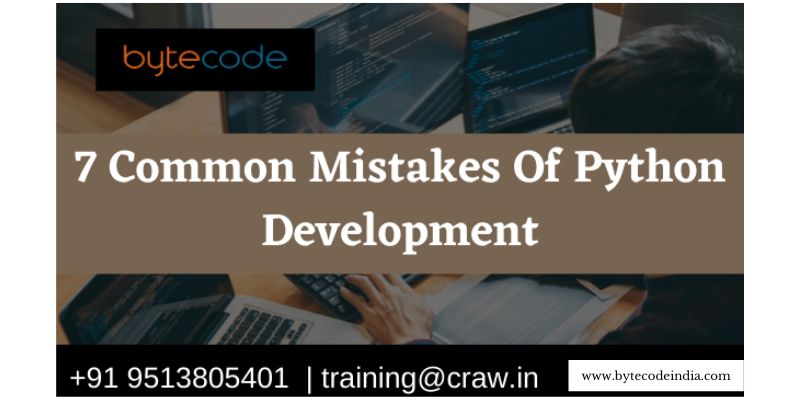7 Common Mistakes Of Python Development
Python is a popular programming language used for application development. It has evolved into an object-oriented, high-level, and powerful language. Python gives developers the power to build applications quickly. However, there are many common mistakes in Python development made by beginners when learning Python.
Learn seven common mistakes in Python development by following the following points:
1. Error Handling:
When people use the Python programming language, they often make mistakes when it comes to handling errors. When you forget a colon at the end of the line or, by mistake, add one space when the identity is under a parenthesis or if statement,. It’s called an encounter or a syntax error.
2. Incorrect Indentation:
If you are a new programmer and looking for information about how to use Python, one of the most common mistakes that you will make is applying improper indentation. Of course, it may be hard to see the error at first glance, but if you look at the code below and compare it with what was intended, then indentation errors will become apparent.
3. Class Variables:
A class variable is a variable declared within a class definition. It can be accessed inside the class but cannot be used outside of it. Class variables are less common mistakes in Python development, but there are a few reasons to use them. In this article, I will explain what they are and provide examples of how to use them to solve certain problems that would otherwise require mutating the state (changing values) of shared variables.
4. Python Standard Library Module Name:
Python is prosperous with out-of-the-box library modules. A usual error is the usage of the same name for modules in the Python standard library.
This directs to carrying different libraries that will attempt to import the module in the Python standard library and because the module has the same name, the other package will import the defined module instead of the Python standard library module.
5. LEGB Rule:
The LEGB rule is a mistake in Python development that you may use to make your code more readable. In Python, it’s spelled as follows:
Rule 1: A leading space character should not appear in a print statement.
Rule 2: An opening parenthesis character should not appear in a print statement.
Rule 3: A closing parenthesis character should not appear in a print statement.
Rule 4: An opening bracket should never be followed by whitespace on each side and at the end of the line.
6. Misusing Expressions:
In Python programming, expressions are those bits of code or text that perform some action, such as assigning a value to a variable or performing mathematical operations on two numbers. While this type of code may be confusing for new programmers, understanding the difference between expressions and statements is an important first step in avoiding mistakes when coding with Python.
7. Variable Binding:
Python includes a package that allows for an object to be assigned to a data type to ensure that the data is handled correctly. For instance, if one assigns an integer object with three decimal points to decimal bindings, the Python interpreter automatically truncates the decimal values after two decimal points when performing operations on this integer.
Conclusion:
In the above briefing of 7 Common Mistakes of Python Development, one might have understood that the Python programming language is not an easy nut to crack as it possesses so many delicate coding programs that one has to study and learn seriously with full concentration. Hence, we will suggest that you start an entry-level program for learning Python Programming Languages with ease. Here, at Bytecode, we offer our premium Best Online Python Training in Delhi which you can do from any remote location of your preferred choice.
FAQs: Mistakes Of Python
1: What is the most common mistake in Python?
There are many mistakes that Python developers usually make, such as the following:
- Error handling
- Incorrect Indentation
- Misusing The __init__ Method
- Class variables use
- Variable Binding
- Python Standard Library Module Names.
- LEGB Rule
2: What’s bad about Python?
Python programming also possesses some flaws inbuilt in it, such as the fact that it is an interpreted language, so it functions with the help of a significant interpreter, but the compiler doesn’t work on Python. Hence, at last, it functions slower in comparison to C, C++, Java, and other programming languages.
In conclusion, we can say that Python’s structures demand more memory space.
3: What are the limitations of Python?
There are some drawbacks or limitations while using the Python Coding Language, such as:
- Performance and speed.
- Incompatibility of Two Versions.
- Does not provide Prebuilt Statistical Models and Tests
- Requires additional testing.
- Many Python Modules Lack Adequate Support
- Weak in mobile computing.
- Depends on third-party frameworks and libraries.
- No Option to Embed Block Comments, etc.
4: What is the ugliest programming language?
This question has thousands of answers on the internet, but we will not judge any language based on its ease of learning capability for a certain user, as it depends from user to user to learn a particular programming language by choice and means. Mistakes: Python is the most chosen programming language among all by the developer fraternity but the other languages are also equally important for usage.
On the index of ease factor, we can put PHP, JavaScript, and C++ as the languages that you are asking for in the same order.
5: What are type errors in Python?
There are certain in-built type errors in Mistakes of Python, which are clusters of errors that show that one has made a particular category of mistake and has to rectify it as soon as possible in a certain code. Type errors are raised when a function or operation is applied to an object of an incorrect type.
Table of Contents

